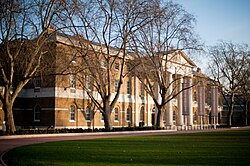The Blitz
On 1 June 1940, along with other AA units equipped with the older 3-inch and newer 3.7-inch and 4.5-inch AA guns, the 52nd was designated a Heavy AA Regiment. [1] [2] By the time of the Battle of Britain and during The Blitz, 52 HAA Regt had returned to 26 AA Bde in 1 AA Division, defending London. [13] [14] [15] [16] [17]
The regiment sent a cadre to 205th HAA Training Regiment at Arborfield to provide the basis for a new 424 HAA Bty; this was formed on 24 April 1941 and joined the regiment on 22 July 1941. It had previously sent a cadre to 207th HAA Training Rgt at Devizes, which had formed 385 HAA Bty on 14 November 1940 for 121st HAA Rgt. The regiment sent a third cadre to 209th HAA Training Regiment at Blandford to form 485 (Mixed) Bty on 25 September 1941, which joined 139th (Mixed) HAA Rgt. ('Mixed' units included women of the Auxiliary Territorial Service (ATS)). [1]
Burma
On 23 November 1944, 52 HAA Regt embarked again and crossed to India to take part in the reconquest of Burma. It spent the whole of December travelling to Palel in Manipur on the Burmese border, where it came under XXXIII Corps in Fourteenth Army to join in the advance across the Chindwin River. [13] [15] [26] [30]
Assigned to 11th (East Africa) Division, it moved east from Imphal to Tamu and down the 'pestilential' Kabaw Valley to the Chindwin to meet 5th (Indian) Division at Kalemyo. 11th EA Division with its AA support then moved north up the Chindwin to Kalewa, an important ferry centre which was to be the crossing site for XXXIII Corps. A bridgehead was secured and the engineers began building a 1100-foot Bailey bridge on pontoons. Japanese air attacks had been slight up to this point, but now their aircraft made a determined attempt to knock out the bridge. Intense concentrations of fire by 52nd and the other AA units broke up the attacks, destroyed six aircraft, and ensured that the bridge remained intact. [31]
As XXXIII Corps launched its main drive from Kalewa in December, 52 HAA Rgt remained behind to defend the bridgehead area, later moving up to guard the line of communications as the Corps advanced towards Mandalay in January 1945. During the approach to Mandalay, the Corps HAA guns were frequently used as Corps medium artillery, bombarding enemy positions. Late in 1944, 52nd HAA Rgt had acquired a section of 7.2-inch howitzers to operate in this role, for which it had to find the detachments, command posts and observation post parties for this unfamiliar duty. [32]
The important airfield at Meiktila was captured by IV Corps on 20 February and turned into a defended 'box' against enemy counter-attacks, and 52nd HAA Rgt was transferred from XXXIII to IV Corps, with 271 Bty moving in to reinforce the box. [33]
As the British advance gained momentum, IV Corps' two divisions, 5th and 17th (Indian), began leap-frogging forwards. 155 and 271 Batteries of 52nd HAA Rgt accompanied 5th Division, while 159 Bty went with 17th Division. The HAA guns were mainly used in the ground role, but when the advance reached Payagyi and Pegu, only 70 miles from Rangoon, the airfield complex and the bridge over the Sittang River required AA cover, for which 271 Bty was deployed against small and scattered air raids. [34]
When Rangoon fell in early May, 24th AA Bde took over responsibility for its air defence, and 52nd HAA Rgt deployed its 24 3.7-inch guns to defend the docks, airfield and oil installations. It remained there when 24 AA Bde was replaced by 3 Indian AA Bde in June. The AA defence role at Rangoon ended in September 1945 and 52nd HAA Rgt was withdrawn. All the British regiments were on their way home by October. [26] [35]
The regiment's former 154 (London) HAA Battery had been converted into Medium Artillery (as part of 63 Medium Battery) in July 1944 and assigned to 87 Medium Regt. It remained in Burma when the rest of 87 Medium Regt returned to India, and on 17 August 1945 it rejoined 52 HAA Regt. [1] [36] It was apparently placed in suspended animation by 1946; the whole regiment with 155, 159 and 271 Btys followed it into suspended animation in the UK on 17 February 1946, completing the process by 10 March. [1]




